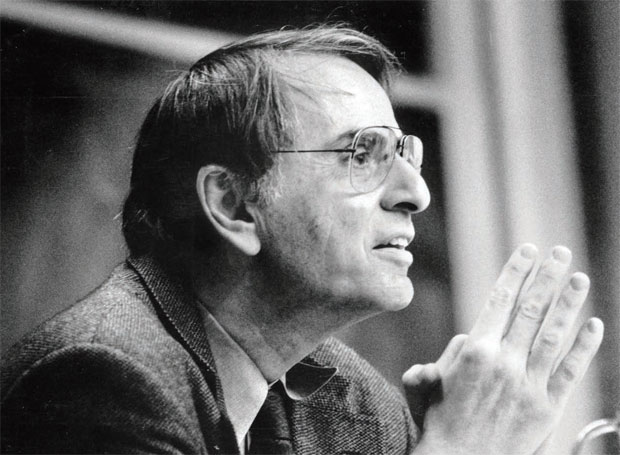
Carl Sagan, 1995
During his nearly three decades at Cornell, Carl Sagan became the best-known scientist on the planet. Unlike previous celebrity researchers, Sagan didn’t achieve fame from a singular breakthrough such as Jonas Salk’s polio vaccine or Albert Einstein’s general theory of relativity. Sagan made significant contributions to planetary research, but his renown derived from his extraordinary ability to communicate the wonders and complexities of science to his students—both in Cornell’s lecture halls and in the wider world he made his classroom.
Sagan’s papers, open to the public at the Library of Congress since November, range over topics as majestic as outer space and as mundane as office space. (If you took Astronomy 102/104 in 1977, your grades are in Box 254.) A sampling of the academic files sheds light on Sagan’s years in Ithaca, from the story of how he came to Cornell to his transformation into the finest science educator of the Space Age generation to his courageous battle against the rare disease that claimed his life at sixty-two.
1967–68 Sagan, who had joined the Harvard faculty as an assistant professor in 1962 when he was twenty-eight, was seemingly on the fast track when he received the stunning news that he would not get tenure. The reasons weren’t clear; there were murmurs that his overriding passion—exobiology, the search for extraterrestrial life—was a discipline without a subject matter. Regardless of why, Sagan began looking for employment elsewhere.
After being rebuffed by MIT, he found himself recruited by Tommy Gold, director of Cornell’s Center for Radiophysics and Space Research. Gold, who was trying to build a world-class astronomy department, was impressed by Harvard’s brash young astronomer, but then-Provost Dale Corson had reservations. “Dale, you will not ever regret this,” Gold assured him.
Sagan’s lack of negotiating leverage didn’t prevent him from spelling out what it would take to bring him to Ithaca. “For me to accept your kind offer to come to Cornell, I would require some firm assurance that the level of staffing, space, and support be slightly above the level outlined,” he wrote in a four-page letter in June 1967. Six months later, Gold responded with the offer of an associate professorship, with tenure and an initial salary of $15,000 a year. Gold helped seal the deal by bringing him to Treman State Park, where Sagan was impressed by the area’s natural beauty.
On January 22, 1968, the Board of Trustees formally appointed Sagan an associate professor in the Department of Astronomy. He responded on Valentine’s Day that he was “delighted to accept” and looked forward to a long period of association with Cornell.The relationship would last nearly half his life.
It wasn’t until five years later that Sagan learned why he’d been snubbed by Harvard and MIT. One of his mentors at the University of Chicago, Nobel laureate Harold Urey, had given him negative references, characterizing Sagan’s research work as wordy, often useless, and not to be trusted. Urey later changed his mind and apologized, asking for forgiveness and friendship. “I have been completely wrong,” he wrote on September 17, 1973. “I admire the things you do and the vigor with which you attack them.” By then, of course, Cornell had already pulled off the greatest Massachusetts-to-New York exchange of talent since the Red Sox sold Babe Ruth to the Yankees in 1920.
1973 Sagan quickly gained a reputation as an unusually engaging lecturer. In spring 1973 he taught Astronomy 102 with Frank Drake ’51, known for devising an equation to estimate the number of intelligent civilizations in the Milky Way. “The room is overflowing,” Drake wrote to him, “and we are oversubscribed.” That April, a discussion on “Science and Science Fiction”—featuring Sagan, Gold, Isaac Asimov, and Fred Hoyle—attracted so many people that hundreds got stuck in the hallway, including astronomy chair Martin Harwit, who publicly apologized for the “fiasco.”
With the publication that year of Sagan’s new book, The Cosmic Connection, his star continued to rise. He went on Dick Cavett’s TV show to talk about the possibility of contact with intelligent life on other planets. Johnny Carson, a knowledgeable amateur astronomer, happened to catch the show and was impressed. Sagan was invited to appear on “Tonight”—but as a relative unknown he was relegated to five minutes at the end of the show, following a talking crow and harmonica-playing hillbillies.
He used the time well, and Carson invited him back three weeks later for a half-hour segment. Sagan’s topic this time was nothing less than the history of the universe. “Fifteen billion years ago, the universe was without form,” he began. “There were no galaxies, stars, or planets. There was no life. There was darkness everywhere.” A New York magazine reviewer called it “one of the great reckless solos of late-night television.”
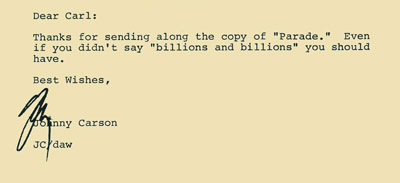 Sagan would go on to make two dozen more appearances on the Carson show, spreading his gospel of science to its 10 million viewers. Back in Ithaca, students would greet his return to the classroom with Ed McMahon-like shouts of “He-e-e-e-re’s Carl!” Carson later introduced a Sagan impression, donning a black wig, turtleneck sweater, and corduroy jacket and intoning “bill-yuns and bill-yuns.” Thus Sagan, in one of the many ironies that marked his life, became perhaps best known for something he insisted he never said. When Carson heard about Sagan’s denial, he sent a “Dear Carl” note to his Cornell office: “Even if you didn’t say ‘billions and billions’ you should have.”
Sagan would go on to make two dozen more appearances on the Carson show, spreading his gospel of science to its 10 million viewers. Back in Ithaca, students would greet his return to the classroom with Ed McMahon-like shouts of “He-e-e-e-re’s Carl!” Carson later introduced a Sagan impression, donning a black wig, turtleneck sweater, and corduroy jacket and intoning “bill-yuns and bill-yuns.” Thus Sagan, in one of the many ironies that marked his life, became perhaps best known for something he insisted he never said. When Carson heard about Sagan’s denial, he sent a “Dear Carl” note to his Cornell office: “Even if you didn’t say ‘billions and billions’ you should have.”
1977 It was perhaps inevitable that Cornell’s most famous scientist and its most famous dropout, both best-selling authors, would cross paths. Kurt Vonnegut ’44, who had spent three years on campus trying to become a scientist before leaving to serve in World War II, had given a favorable review to Sagan’s first book, Intelligent Life in the Universe, written in 1966 with Soviet scientist I. S. Shklovskii. In 1977, Sagan sent Vonnegut a copy of The Dragons of Eden, his excursion into the origins of human intelligence that went on to win the Pulitzer Prize. “I’m so glad to have The Dragons of Eden, a shapely companion for The Cosmic Connection,” Vonnegut wrote back. “You make it so easy for a lazy person like me to have some inkling, all the same, of what may really be going on. All this new information is going to have to be incorporated into sermons by and by.” Vonnegut went on to discuss plans for a new work of science fiction, which opened with a message to Earth from the planet Tralfamadore.
Sagan thanked Vonnegut for the message from the Tralfamadorians and wondered whether there is “any chance of you visiting your old Alma Mater—say, to give a university-wide lecture?” To which Vonnegut replied: “We might come up there to look around sometime. I’d like to steal my transcripts and burn them, if possible. As for lecturing: It makes me feel seasick, so I don’t do it any more.”
1980–81 Although Sagan was already well known beyond Cornell, it was “Cosmos,” seen by more than 500 million people in sixty countries, that propelled him into the stratosphere and earned him such sobriquets as “the prince of popularizers” and “the cosmic explainer.” In thirteen hour-long episodes, Sagan served as a telegenic tour guide to the universe, with an engaging sprinkling of philosophy, religion, music, art, and history along the way.
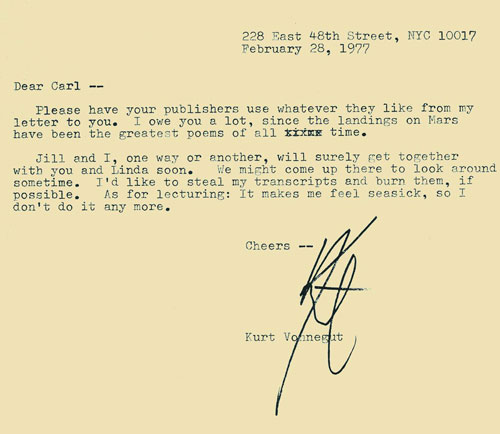 When Sagan returned to Ithaca after a two-year leave to make “Cosmos,” his international celebrity attracted a deluge of appeals for interviews, invitations for speaking engagements, requests for career advice, fan mail, and letters from crackpots (which were placed in bulging files labeled “fissured ceramics”). To protect Sagan and Shirley Arden, his dedicated and swamped assistant, a special alarm system was installed in the Space Sciences Building.
When Sagan returned to Ithaca after a two-year leave to make “Cosmos,” his international celebrity attracted a deluge of appeals for interviews, invitations for speaking engagements, requests for career advice, fan mail, and letters from crackpots (which were placed in bulging files labeled “fissured ceramics”). To protect Sagan and Shirley Arden, his dedicated and swamped assistant, a special alarm system was installed in the Space Sciences Building.
In January 1981, Harold Urey died of heart disease at age eighty-seven. Sagan wrote a long obituary for the journal Icarus hailing him as one of the founders of modern planetary science. Deep in the obituary was this cryptic sentence: “I remember his willingness to change his mind in a case where he had blocked the advancement to tenure of a young scientist at another institution and then later asked to be forgiven.”
1988 By his twentieth year in Ithaca, Sagan was growing frustrated by what he called “the almost imperceptible level of Cornell financial support for my work.” In a confidential memo to the director of the Center for Radiophysics and Space Research and the chairman of astronomy, Sagan pointed out that between May and December, he had contributed $31,995 to cover costs associated with office equipment and a senior research associate. “By comparison, my half-time salary at Cornell for academic year 1987–88 is only $29,500. I am in the absurd situation of contributing more money to Cornell than Cornell pays me.” Sagan proposed that “an equitable solution” would be for the University to increase non-salary funds to support his research and other activities by an additional $35,000 a year—though even that “would not equal the level of non-salary support that other universities and institutions continue to offer me.”
 Sagan’s discontent got the attention of Day Hall. In a letter from Provost Robert Barker, the University offered an additional $30,000 in honoraria in exchange for two public lectures a year. That summer, Sagan delivered the freshman orientation talk in Bailey Hall. ” “I think if you play your cards right you can have an excellent educational experience at Cornell,” he said. “And it’s even possible that it can be a character-building experience, but that’s a much iffier prospect—much more up to you.”
Sagan’s discontent got the attention of Day Hall. In a letter from Provost Robert Barker, the University offered an additional $30,000 in honoraria in exchange for two public lectures a year. That summer, Sagan delivered the freshman orientation talk in Bailey Hall. ” “I think if you play your cards right you can have an excellent educational experience at Cornell,” he said. “And it’s even possible that it can be a character-building experience, but that’s a much iffier prospect—much more up to you.”
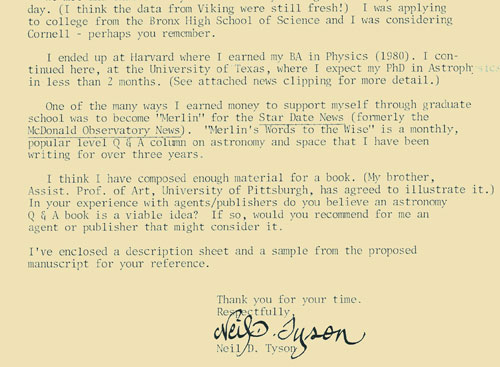
1994 To honor Sagan’s sixtieth birthday, Cornell sponsored a symposium on October 13–14. (Sagan was born on November 9, but the event was scheduled a month earlier to avoid problems with Ithaca’s notoriously fickle weather.) A galaxy of scientists, diplomats, artists, and journalists converged on the campus. Also in attendance were Sagan’s five children from three marriages, one born in each decade from the Fifties to the Nineties.
Bailey Hall was standing-room-only for Sagan’s keynote lecture on “The Age of Exploration.” As the lights dimmed, he pointed to a tiny pixel of light projected on a giant screen above him. He identified it as a photograph of Earth taken by the Voyager spacecraft as it departed the solar system. Sagan had persuaded NASA to adjust the cameras for this final, backward glance.
The auditorium was hushed except for Sagan’s signature, cadenced voice. That night, he delivered one of his most memorable lectures, one that struck some in the audience as almost biblical in tone and message:
Look again at that dot. . . . On it everyone you love, everyone you know, everyone you ever heard of, every human being who ever was, lived out their lives. . . .
The Earth is a very small stage in a vast cosmic arena. Think of the rivers of blood spilled by all those generals and emperors so that, in glory and triumph, they could become the momentary masters of a fraction of a dot. Think of the endless cruelties visited by the inhabitants of one corner of this pixel on the scarcely distinguishable inhabitants of some other corner; how frequent their misunderstandings, how eager they are to kill one another; how fervent their hatreds.
Our posturings, our imagined self-importance, the delusion that we have some privileged position in the universe, are challenged by this point of pale light. Our planet is a lonely speck in the great enveloping cosmic dark. In our obscurity, in all this vastness, there is no hint that help will come from elsewhere to save us from ourselves. . . .
There is perhaps no better demonstration of the folly of human conceits than this distant image of our tiny world. To me, it underscores our responsibility to deal more kindly with one another, and to preserve and cherish the pale blue dot, the only home we’ve ever known.
1995–96 Just weeks after his sixtieth birthday, Sagan was diagnosed with myelodysplasia, a rare bone marrow disease. On March 13, 1995, he took leave for treatment, and on April 7 he underwent a bone marrow transplant at Seattle’s Fred Hutchinson Cancer Research Center. Word of his illness sparked an outpouring of well-wishes from around the world, including notes from Cornell colleagues, President Bill Clinton, a sixth-grade science class in New Mexico, and fans bearing chicken soup recipes. Sagan tried to respond to each one.
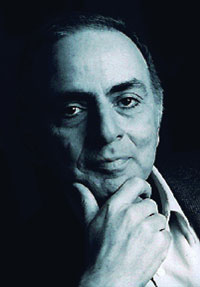 Sagan continued working feverishly, completing The Demon-Haunted World: Science as a Candle in the Dark. The book was a passionate defense of rationality against a rising tide of pseudo-science—and a prescient warning that the increasing power of science, combined with widespread ignorance about it, “is a prescription for disaster.” Despite health setbacks and a new round of radiation treatments in the summer of 1996, Sagan expressed optimism about coming back to Cornell in October. The Daily Sun reported on November 11 that he was planning to teach Astronomy 202 in the spring.
Sagan continued working feverishly, completing The Demon-Haunted World: Science as a Candle in the Dark. The book was a passionate defense of rationality against a rising tide of pseudo-science—and a prescient warning that the increasing power of science, combined with widespread ignorance about it, “is a prescription for disaster.” Despite health setbacks and a new round of radiation treatments in the summer of 1996, Sagan expressed optimism about coming back to Cornell in October. The Daily Sun reported on November 11 that he was planning to teach Astronomy 202 in the spring.
On December 4, Sagan was interviewed on ABC’s “Nightline” from his home in Ithaca. Host Ted Koppel, concerned by his guest’s gaunt appearance, opened by inquiring about his health. Sagan replied: “I’m terrific. I’ve been very, very lucky and it looks like I’m out of the woods.” Then: “We won’t be sure for another year, a year and a half, but things couldn’t look better.” As time was running out on the seven-minute segment, Koppel asked for some final thoughts. Sagan smiled. “We live,” he said, “on a hunk of rock and metal that circles a humdrum star that is one of 400 billion other stars that make up the Milky Way galaxy, which is one of billions of other galaxies. . . . That is a perspective on human life and our culture that’s well worth pondering.”
It would be Sagan’s last message to a national audience. Within days of the “Nightline” interview, he contracted pneumonia and again returned to Seattle for treatment. This time, however, there would be no recovery. In the early morning hours of Friday, December 20, with his wife and collaborator Ann Druyan and other family members at his side, Sagan drew his last breath. One of his noted astronomical observations—”even the stars must die”—also served as a personal epitaph.
•
Carl Sagan was buried three days later at Lakeview Cemetery in Ithaca, in a hillside family plot protected by a copse of evergreens. A memorial was held on February 3, 1997, in Bailey Hall, a short walk across the parking lot from Sagan’s old office in Space Sciences. Perhaps the most eloquent tribute was delivered by President Emeritus Frank Rhodes. Sagan, he said, “asked the big questions that others had given up. He confronted the painful issues that others sidestepped. He leapt over conventional boundaries by which others were constrained. Not for him was the pursuit of science an activity of a closed and inward-looking guild: for him, science was a means of public understanding and enlightenment.”
Bill Sternberg ’78 is deputy editorial page editor of USA Today and a member of the Cornell Alumni Magazine Committee. He took Sagan’s Astronomy 102 class in Spring 1975 and interviewed him for the Daily Sun about the Viking landers’ search for life on Mars.
‘Family Guy’ to Science Guy
Sagan inspired many—including an unlikely benefactor
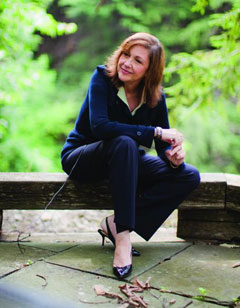
Ann Druyan
For sixteen years after Carl Sagan’s death, his voluminous papers were stored in the building at 900 Stewart Avenue, known as the Sphinx Head tomb, that was once his home office. If not for Seth MacFarlane, they might still be there.
MacFarlane—”Family Guy” creator, film director, and supporter of science education—made a donation through his foundation that enabled the Library of Congress to acquire the collection from Ann Druyan, Sagan’s widow and collaborator. To make the transfer happen, “I literally wrote a check,” says MacFarlane. (A Library official puts the figure at $2 million.)
The papers were moved to Washington in 2012, and last November the Seth MacFarlane Collection of the Carl Sagan and Ann Druyan Archive was opened to researchers. The Cornell files account for about 100 of the 1,705 boxes. Eventually, some of the material will be available online.
The collection contains Sagan’s earliest childhood musings, extensive correspondence with leading scientists and political figures, drafts of more than 600 research papers, and information about his investigations into subjects ranging from the origins of life to global warming to the impact of nuclear warfare. “The astonishing thing about this collection is that his mother began assembling it when he was in utero,” says Druyan. “Every report card, every note home, was saved lovingly.”
Why didn’t the collection end up at Cornell? Druyan says she and President Emeritus Frank Rhodes made several attempts to get the University to acquire the papers as the foundation of a new science communication school, but “we could never interest the administration.” Asked about this, University spokesman John Carberry declined to comment.
Druyan says she hopes the collection will inspire future scientific research and will show Sagan to have been unselfishly conscientious, with an overriding sense of concern for the public good. And the documents that might not cast him in such a flattering light? “Human beings are not perfect,” she says. “Whatever faults he had—and he certainly had them—the easiest way to make him laugh was to make a joke at his expense.” She says Sagan would have loved the fact that MacFarlane’s name ended up on his archive, in part because three of his children are “Family Guy” fans.
“Like millions of other science lovers, I was heavily influenced by Carl Sagan [when I was] growing up,” MacFarlane said at the collection’s opening celebration. “He was the only way we got our science information in a digestible form. He made it accessible; he made it exciting to people who weren’t going to be mathematicians or physicists.”
Bill Nye ’77 told the audience that taking Sagan’s astronomy class changed him profoundly by making him a skeptic and critical thinker. At his 10th Reunion, Nye recalled, he wrangled a five-minute meeting with Sagan that led directly to what became the popular “Bill Nye the Science Guy” show.
An updated version of the “Cosmos” series, produced by MacFarlane and Druyan and hosted by astrophysicist Neil deGrasse Tyson, debuts March 9 on the Fox and National Geographic networks. Tyson has his own connection to Sagan. In the mid-Seventies, when he was attending the Bronx High School of Science and deciding on colleges, he visited Cornell on a snowy autumn day. Sagan met with him and drove him back to the Ithaca bus station in his Porsche.
Tyson, now the director of New York’s Hayden Planetarium, wound up going to Harvard.


